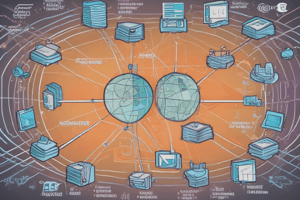Podcast
Questions and Answers
What does the MAC sublayer do in the Data Link layer?
What does the MAC sublayer do in the Data Link layer?
- Handles data transmission between hosts and implements flow control
- Acts as an interface between the MAC and Physical layers
- Controls the hardware and provides flow control (correct)
- Defines unique hardware addresses and verifies data accuracy
Which layer of the OSI model defines how physical network devices are identified?
Which layer of the OSI model defines how physical network devices are identified?
- Transport Layer
- Data Link Layer
- Physical Layer (correct)
- Network Layer
What is the function of the Logical Link Control (LLC) sublayer?
What is the function of the Logical Link Control (LLC) sublayer?
- Interfaces between MAC and Network layers (correct)
- Provides standards for cables and connectors
- Defines physical network device identification
- Controls the rate of data transmission between hosts
Which layer of the OSI model sets standards for sending electrical signals between devices?
Which layer of the OSI model sets standards for sending electrical signals between devices?
What do frames represent at the Data Link layer?
What do frames represent at the Data Link layer?
Which network devices function in Layer 2 of the OSI model?
Which network devices function in Layer 2 of the OSI model?
Which layer is responsible for managing multiple sessions and assigning session IDs?
Which layer is responsible for managing multiple sessions and assigning session IDs?
What is the primary function of the Transport layer?
What is the primary function of the Transport layer?
Which layer is responsible for identifying hosts and networks using logical addresses?
Which layer is responsible for identifying hosts and networks using logical addresses?
What is the unit of data at the Transport layer called?
What is the unit of data at the Transport layer called?
Which layer defines the rules and procedures for hosts to access the Physical layer?
Which layer defines the rules and procedures for hosts to access the Physical layer?
What is the unit of data at the Network layer called?
What is the unit of data at the Network layer called?
Which of the following is NOT a service typically associated with the Application layer?
Which of the following is NOT a service typically associated with the Application layer?
What is the main function of the Presentation layer?
What is the main function of the Presentation layer?
Which of the following is NOT a function of the Presentation layer?
Which of the following is NOT a function of the Presentation layer?
What does a 'session' refer to in the context of the Session layer?
What does a 'session' refer to in the context of the Session layer?
Which layer of the OSI model is responsible for integrating network functionality into the host operating system?
Which layer of the OSI model is responsible for integrating network functionality into the host operating system?
Which of the following statements about the Application layer is NOT true?
Which of the following statements about the Application layer is NOT true?
What is one of the functions of the Transport layer in the OSI model?
What is one of the functions of the Transport layer in the OSI model?
In the OSI model, what task is NOT a responsibility of the Network layer?
In the OSI model, what task is NOT a responsibility of the Network layer?
What is a primary characteristic of the Data Link layer in the OSI model?
What is a primary characteristic of the Data Link layer in the OSI model?
Which statement accurately describes session management at the Session layer?
Which statement accurately describes session management at the Session layer?
What distinguishes the responsibilities of the Transport layer from those of the Data Link layer in the OSI model?
What distinguishes the responsibilities of the Transport layer from those of the Data Link layer in the OSI model?
Which function is NOT performed by the Network layer in the OSI model?
Which function is NOT performed by the Network layer in the OSI model?
What is the primary role of the Application layer?
What is the primary role of the Application layer?
Which layer is responsible for encrypting and compressing data?
Which layer is responsible for encrypting and compressing data?
What does a 'session' refer to in the context of the OSI model?
What does a 'session' refer to in the context of the OSI model?
Which of the following is NOT a service typically associated with the Application layer?
Which of the following is NOT a service typically associated with the Application layer?
Which statement accurately describes the Presentation layer?
Which statement accurately describes the Presentation layer?
Which layer of the OSI model is responsible for establishing and managing sessions between applications?
Which layer of the OSI model is responsible for establishing and managing sessions between applications?
What does the Logical Link Control (LLC) sublayer provide in the Data Link layer?
What does the Logical Link Control (LLC) sublayer provide in the Data Link layer?
Which aspect of data handling is NOT a responsibility of the MAC sublayer in the Data Link layer?
Which aspect of data handling is NOT a responsibility of the MAC sublayer in the Data Link layer?
What is the primary function of the Physical layer in the OSI model?
What is the primary function of the Physical layer in the OSI model?
Which network devices operate at Layer 2 of the OSI model?
Which network devices operate at Layer 2 of the OSI model?
What do frames represent at the Data Link layer?
What do frames represent at the Data Link layer?
Which layer of the OSI model establishes rules for error-free data transmission?
Which layer of the OSI model establishes rules for error-free data transmission?
What does the Media Access Control (MAC) layer in the Data Link layer provide?
What does the Media Access Control (MAC) layer in the Data Link layer provide?
Which layer sets standards for sending and receiving electrical signals between devices?
Which layer sets standards for sending and receiving electrical signals between devices?
What is the primary function of the Logical Link Control (LLC) sublayer?
What is the primary function of the Logical Link Control (LLC) sublayer?
What do frames represent at the Data Link layer?
What do frames represent at the Data Link layer?
Which network devices operate at Layer 2 of the OSI model?
Which network devices operate at Layer 2 of the OSI model?
What distinguishes the responsibilities of the Transport layer from those of the Data Link layer in the OSI model?
What distinguishes the responsibilities of the Transport layer from those of the Data Link layer in the OSI model?
Which of the following protocols operates at multiple layers down to the Session and even Transport layers?
Which of the following protocols operates at multiple layers down to the Session and even Transport layers?
What is the primary responsibility of the Presentation layer in the OSI model?
What is the primary responsibility of the Presentation layer in the OSI model?
Which of the following is NOT a responsibility of the Presentation layer?
Which of the following is NOT a responsibility of the Presentation layer?
What is the primary function of the Session layer in the OSI model?
What is the primary function of the Session layer in the OSI model?
Which of the following statements is NOT true about the Application layer?
Which of the following statements is NOT true about the Application layer?
Which layer of the OSI model is responsible for encrypting and compressing data?
Which layer of the OSI model is responsible for encrypting and compressing data?
What is the primary function of the Application layer in the OSI model?
What is the primary function of the Application layer in the OSI model?
Which of the following is NOT a responsibility of the Presentation layer?
Which of the following is NOT a responsibility of the Presentation layer?
In the context of the OSI model, what does a 'session' refer to?
In the context of the OSI model, what does a 'session' refer to?
Which of the following statements accurately describes the role of the Transport layer?
Which of the following statements accurately describes the role of the Transport layer?
What is the primary function of the Network layer in the OSI model?
What is the primary function of the Network layer in the OSI model?
Which of the following statements accurately describes the Data Link layer?
Which of the following statements accurately describes the Data Link layer?
What is the primary responsibility of the Session layer in the OSI model?
What is the primary responsibility of the Session layer in the OSI model?
Which layer of the OSI model is responsible for converting data into a format suitable for transmission over the physical medium?
Which layer of the OSI model is responsible for converting data into a format suitable for transmission over the physical medium?
What is the primary function of the Presentation layer in the OSI model?
What is the primary function of the Presentation layer in the OSI model?
Which of the following statements accurately describes the role of the Application layer in the OSI model?
Which of the following statements accurately describes the role of the Application layer in the OSI model?
Which layer of the OSI model is responsible for ensuring reliable end-to-end data delivery?
Which layer of the OSI model is responsible for ensuring reliable end-to-end data delivery?
What is the primary function of the Media Access Control (MAC) sublayer in the Data Link layer?
What is the primary function of the Media Access Control (MAC) sublayer in the Data Link layer?
Flashcards are hidden until you start studying
Study Notes
OSI Model Layer Functions
Physical (Layer 1)
- Sets standards for sending and receiving electrical signals between devices
- Protocols identify:
- Conversion of digital data (bits) to electric pulses, radio waves, or pulses of light
- Specifications for cables and connectors
- The physical topology
- Bits are data segments at the Physical layer
Data Link (Layer 2)
- Defines the rules and procedures for hosts as they access the Physical layer
- Has two sublayers:
- Logical Link Control (LLC) - upper sublayer
- Is an interface between the MAC sublayer and the Network layer
- Provides flow control and transmission for analog and/or digital streams over a shared link for the logical link
- Media Access Control (MAC) - lower sublayer
- Controls the hardware
- Provides flow control and transmission for analog and/or digital streams over a shared link
- Logical Link Control (LLC) - upper sublayer
- Frames are data segments at the Data Link layer
- Switches, bridges, NICs, and WAPs function in Layer 2
Network (Layer 3)
- Describes how data is routed across networks and on to the destination
- Identifies hosts and networks by using logical addresses
- Maintains a list of known networks and neighboring routers
- Determines the next network point where data should be sent
- To select the optimal path for data, routers use a routing protocol that takes various factors into account, such as:
- Number of hops in the path
- Link speed
- Link reliability
- A packet is a data segment at the Network layer
Transport (Layer 4)
- Provides a transition between the upper and lower layers of the OSI model
- Makes the upper and lower layers transparent to each other
- Functions include:
- End-to-end flow control
- Port and socket number assignment
- Segmentation, sequencing, and combination
- Connection services, either reliable (connection-oriented) or unreliable (connectionless) delivery of data
- A data segment is a unit of data at the Transport layer
Session (Layer 5)
- Manages the sessions in which data are transferred
- A session refers to each client connection
- Functions include:
- Management of multiple sessions
- A server can concurrently maintain thousands of sessions
- Assignment of a session ID number to each session to keep data streams separate
- The setup, maintenance, and teardown of communication sessions
Presentation (Layer 6)
- Formats (presents) data in a form compatible for receipt by the Application layer or the destination system
- Functions include:
- Formats and translates data between systems
- Negotiates data transfer syntax between systems
- Converts character sets to the correct format
- Encapsulates data into message envelopes
- Encrypts and compresses the data
- Restores data through decryption and decompression
Application (Layer 7)
- Integrates network functionality into the host operating system and enables communication between network clients and services
- Does not include specific applications that provide services, but rather provides the capability for services to operate on the network
- Most Application layer protocols operate at multiple layers down to the Session and even Transport layers
- Services typically associated with the Application layer include:
- Hypertext Transfer Protocol (HTTP)
- Telnet
- File Transfer Protocol (FTP)
- Trivial File Transfer Protocol (TFTP)
- Simple Network Management Protocol (SNMP)
Studying That Suits You
Use AI to generate personalized quizzes and flashcards to suit your learning preferences.




